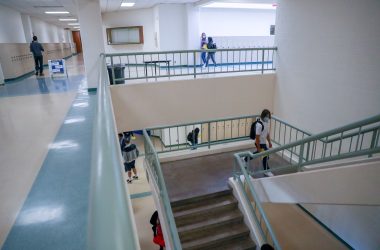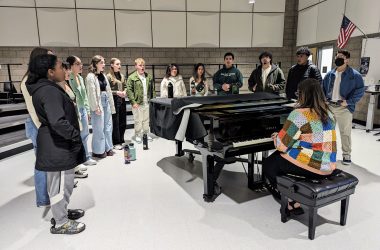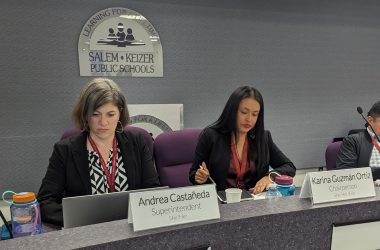 School bus driver Tammie Jones spoons peaches into cups for grab-and-go school meals at the Salem-Keizer Career Technical Education Center on Nov. 24 (Rachel Alexander/Salem Reporter)
School bus driver Tammie Jones spoons peaches into cups for grab-and-go school meals at the Salem-Keizer Career Technical Education Center on Nov. 24 (Rachel Alexander/Salem Reporter)
No students are eating lunch in the oversized cafeteria, but the Salem-Keizer School District’s Career Technical Education Center in northeast Salem is full of sandwiches, apples, carrots and brown bags.
With school remaining online into the new year, the school system has turned its center for hands-on technical classes into a hub for delivering thousands of meals each day to kids who can’t get to a nearby school for the food.
On a recent morning, Tammie Jones scooped canned pears into cups for the next day’s meals. She’s one of 44 bus drivers now working to assemble brown bags, each containing a school lunch and breakfast.
“I miss seeing my kids, but you know we’re feeding them, so that’s important too,” she said.
Bus drivers and food service workers start filing in around 7 a.m. to load insulated plastic bins marked with the name of the school or other drop site.
Some drivers, like Jones, package meals. Others drive them to apartment complexes and store parking lots around the district.
Rolling carts of food are loaded via the bus wheelchair lifts. Two drivers go out on each bus, setting up shop from 11 a.m. to 1 p.m. daily at about 50 locations to pass out food to families living nearby.
It’s all possible because of federal changes to the school meal program which gave school districts more flexibility in the face of the pandemic, said Mac Lary, Salem-Keizer’s food services director. He works for Sodexo, the company contracted to deliver school meals.
 School meals wait to be loaded onto buses for delivery at the Salem-Keizer Career Technical Education Center on Nov. 24 (Rachel Alexander/Salem Reporter)
School meals wait to be loaded onto buses for delivery at the Salem-Keizer Career Technical Education Center on Nov. 24 (Rachel Alexander/Salem Reporter)
When school is in session, Lary said they typically serve 28,000 to 31,000 meals daily – mostly breakfasts and lunches, with some suppers as part of after-school programs.
Seven in ten local kids come from families with incomes that qualify them receive meals for free. Others pay a few dollars for lunch. The U.S. Department of Agriculture covers much of the cost.
When schools shut down in March, Sodexo began preparing brown bag lunches for students to pick up at neighborhood schools. Meals were free for every student then.
Lary said federal rules have continued into the fall, allowing school districts to serve free meals to anyone 18 or under, without having to verify income or enrollment in a local school.
Demand in the spring hit about 18,000 meals daily, he said.
The district and Sodexo set up the bus delivery program at the start of the school year once it was clear schools wouldn’t be reopening for normal classes. They wanted to reach kids who live too far from their neighborhood school, typically over a mile, to walk over for lunch.
Transportation workers examined bus routes and figured out good drop sites, about 50 total across the district.
Bus drivers became licensed food handlers and learned about temperature checking food. The brown bag assembly line was set up across long tables in the cafeteria.
“The first couple days were a little chaotic,” Lary said.
 Bus drivers bag carrots for school lunches at the Salem-Keizer Career Technical Education Center on Nov. 24 (Rachel Alexander/Salem Reporter)
Bus drivers bag carrots for school lunches at the Salem-Keizer Career Technical Education Center on Nov. 24 (Rachel Alexander/Salem Reporter)
Now, bus drivers get between 4,000 and 5,000 meals out to local kids every day. Across the district, Lary said they’re serving 14,000 to 16,000 meals daily between the delivery stops and local schools, where cafeteria workers pass out brown bags and milk.
If meals aren’t picked up, they come back to storage at the end of the day and get temperature checked to ensure they’re still safe to eat, said Delores Tesky, Sodexo’s executive chef for the region.
Those meals, typically about 500 per day, will be handed out first the following day to avoid food waste, Tesky said. Any that come back again are donated to the Union Gospel Mission, she said.
The effort is keeping 135 school bus drivers busy, and giving many a chance to interact with kids, something they’ve missed since schools shut down in March.
“It’s a lot of fun because the students recognize the bus drivers from being on the bus,” Tesky said.
Todd Zelmer, who’s been a bus driver for two years, now drives to south Salem to hand out food. The kids who come don’t linger or spend much time talking, he said, but Zelmer said he still appreciates seeing them.
“I liked it. It was something to do to help the community,” he said.
Contact reporter Rachel Alexander: [email protected] or 503-575-1241.
HOLIDAY SPECIAL: SAVE 25% off a one-year subscription to Salem Reporter. Get quality Salem news delivered to your inbox. Every subscription helps build coverage of the Salem community. Order online HERE.

Rachel Alexander is Salem Reporter’s managing editor. She joined Salem Reporter when it was founded in 2018 and covers city news, education, nonprofits and a little bit of everything else. She’s been a journalist in Oregon and Washington for a decade. Outside of work, she’s a skater and board member with Salem’s Cherry City Roller Derby and can often be found with her nose buried in a book.









